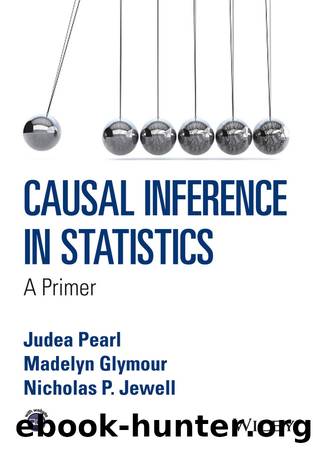Causal Inference in Statistics: A Primer by Judea Pearl & Madelyn Glymour & Nicholas P. Jewell

Author:Judea Pearl & Madelyn Glymour & Nicholas P. Jewell [Pearl, Judea]
Language: eng
Format: azw3
ISBN: 9781119186861
Publisher: Wiley
Published: 2016-01-24T16:00:00+00:00
Figure 3.8 Causal graph used to illustrate the backdoor criterion in the following study questions
Study question 3.3.2 (Lord's paradox)
At the beginning of the year, a boarding school offers its students a choice between two meal plans for the year: Plan A and Plan B. The students' weights are recorded at the beginning and the end of the year. To determine how each plan affects students' weight gain, the school hired two statisticians who, oddly, reached different conclusions. The first statistician calculated the difference between each student's weight in June () and in September () and found that the average weight gain in each plan was zero. The second statistician divided the students into several subgroups, one for each initial weight, . He finds that for each initial weight, the final weight for Plan B is higher than the final weight for Plan A.
So, the first statistician concluded that there was no effect of diet on weight gain and the second concluded there was.
Figure 3.9 illustrates data sets that can cause the two statisticians to reach conflicting conclusions. Statistician-1 examined the weight gain , which, for each student, is represented by the shortest distance to the 45 line. Indeed, the average gain for each diet plan is zero; the two groups are each situated symmetrically relative to the zero-gain line, . Statistician-2, on the other hand, compared the final weights of plan A students to those of plan B students who entered school with the same initial weight and, as the vertical line in the figure indicates, plan B students are situated above plan A students along this vertical line. The same will be the case for any other vertical line, regardless of .
(a) Draw a causal graph representing the situation.
(b) Determine which statistician is correct.
(c) How is this example related to Simpson's paradox?
Download
This site does not store any files on its server. We only index and link to content provided by other sites. Please contact the content providers to delete copyright contents if any and email us, we'll remove relevant links or contents immediately.
| Biomathematics | Differential Equations |
| Game Theory | Graph Theory |
| Linear Programming | Probability & Statistics |
| Statistics | Stochastic Modeling |
| Vector Analysis |
Weapons of Math Destruction by Cathy O'Neil(5037)
Factfulness: Ten Reasons We're Wrong About the World – and Why Things Are Better Than You Think by Hans Rosling(4021)
Factfulness_Ten Reasons We're Wrong About the World_and Why Things Are Better Than You Think by Hans Rosling(2754)
Descartes' Error by Antonio Damasio(2731)
A Mind For Numbers: How to Excel at Math and Science (Even If You Flunked Algebra) by Barbara Oakley(2691)
TCP IP by Todd Lammle(2639)
Applied Predictive Modeling by Max Kuhn & Kjell Johnson(2478)
Fooled by Randomness: The Hidden Role of Chance in Life and in the Markets by Nassim Nicholas Taleb(2413)
The Book of Numbers by Peter Bentley(2404)
The Tyranny of Metrics by Jerry Z. Muller(2401)
The Great Unknown by Marcus du Sautoy(2186)
Once Upon an Algorithm by Martin Erwig(2149)
Easy Algebra Step-by-Step by Sandra Luna McCune(2117)
Practical Guide To Principal Component Methods in R (Multivariate Analysis Book 2) by Alboukadel Kassambara(2093)
Lady Luck by Kristen Ashley(2073)
Police Exams Prep 2018-2019 by Kaplan Test Prep(2033)
Linear Time-Invariant Systems, Behaviors and Modules by Ulrich Oberst & Martin Scheicher & Ingrid Scheicher(1983)
All Things Reconsidered by Bill Thompson III(1960)
Secrets of Creation, Volume 1: The Mystery of the Prime Numbers by Watkins Matthew(1864)
